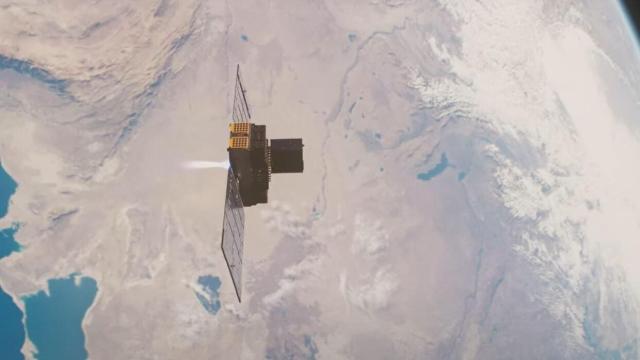California-based Momentus is currently performing its first test of an orbital transfer vehicle known as Vigoride-3, but the 180-day demo mission is off to a rocky start.
The Vigoride-3 orbital transfer vehicle, in space since late May, is running on low power and likely won’t be able to deploy any more satellites to low Earth orbit, according to the latest Momentus update. Solar arrays that were folded for launch failed to open, resulting in the current power and communications issues with Vigoride-3. That communication frequencies might’ve been misconfigured prior to launch hasn’t helped matters.
Known as a “space tug,” the Vigoride spacecraft is designed to carry and deploy small satellites to specific orbital locations. Once in orbit, Vigoride will use its innovative thrusters to manoeuvre in space. It was supposed to deploy nine payloads for several customers over the course of this 180-day mission, as a company spokesperson confirmed in an email. In addition, Momentus was hoping to test Vigoride’s Microwave Electrothermal Thruster, which uses water as a propellant, but that’s now in doubt.
“We are continuing efforts to address the anomalies, but our level of confidence that we will be able to deploy additional customer satellites from Vigoride and perform some planned operations of the vehicle on this test and demonstration mission has substantially declined,” the company said.
Vigorde-3 launched as a paying participant of SpaceX’s Transporter 5 mission, which used a Falcon 9 rocket to deliver dozens of payloads to low Earth orbit. This marked the fifth dedicated smallsat rideshare mission for SpaceX. It launched on May 25 from Canaveral Space Force Station in Florida.
The Vigoride mission began to falter almost immediately. The deployable solar array, folded for launch, “did not operate as intended once in orbit,” according to the Momentus update, which carefully mentioned that the solar arrays were developed by a third party. Solar panels mounted to the body of the spacecraft are functioning, but the glitch with the solar arrays resulted in the power and communications issues with Vigoride.
“We have been working closely with the third-party producer of the solar arrays, and in collaboration with that company have identified what we believe is the root cause of the arrays not operating as intended,” the company press release said. “We also believe we have identified the likely root cause of the other anomalies, although further analysis continues.”
Controllers are currently using an unplanned frequency to maintain communications with the spacecraft. Momentus had to reach out to the Federal Communications Commission and apply for a Special Temporary Authority (STA), receiving approval for a 30-day STA on June 9. The company is using an unplanned frequency because the uplink and downlink frequencies of the spacecraft’s communication system were misconfigured, according to SpaceNews. Early on in the mission, ground controllers were able to establish two-way communication with Vigoride, but that stopped as a likely result of the low power situation, Momentus said.
“During this first launch of the Vigoride vehicle to space, we have learned a great deal and plan to incorporate improvements in other Vigoride vehicles currently being assembled and ground-tested. This was the primary purpose of this initial Vigoride mission,” John Rood, CEO of Momentus, said in the statement. “As we stated prior to the launch, we fully expected to experience challenges during this test and demonstration mission and to learn from them, which is what we are doing.” To which he added: “Space is a notoriously unforgiving environment.”
On the day of the launch, Momentus used a second port on the Falcon 9 to deploy five satellites, and on May 28 it managed to deploy two satellites from Vigoride itself. The company has since tried to deploy the remaining seven satellites but hasn’t been able to confirm anything beyond the first batch.
Despite these setbacks, Momentus is maintaining its launch schedule for the current year and into 2023. This includes the SpaceX Transporter 6 rideshare mission, currently scheduled for launch in November 2022.
More: Two NASA Satellites Likely Fell Into the Ocean After Failed Astra Rocket Launch.
